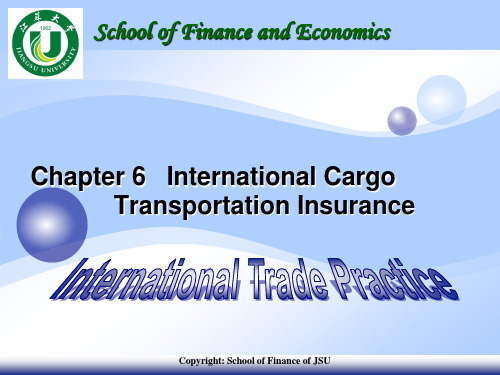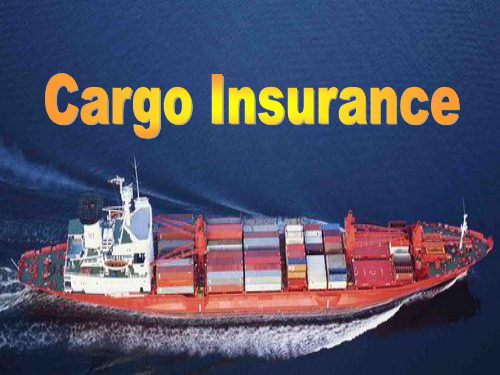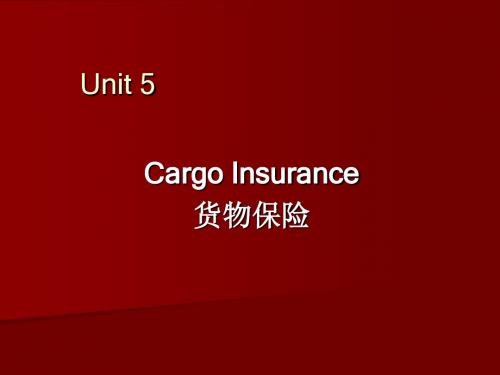6 chapter 6 cargo insurance(2)
- 格式:ppt
- 大小:298.00 KB
- 文档页数:23

海洋运输货物保险条款一、责任范围本保险分为平安险、水渍险及一切险三种。
被保险货物遭受损失时,本保险按照保险单上订明承保险别的条款规定,负赔偿责任。
(一)平安险本保险负责赔偿:1.被保险货物在运输途中由于恶劣气候、雷电、海啸、地震、洪水自然灾害造成整批货物的全部损失或推定全损。
当被保险人要求赔付推定全损时,须将受损货物及其权利委付给保险公司。
被保险货物用驳船运往或运离海轮的,每一驳船所装的货物可视作一个整批。
推定全损是指被保险货物的实际全损已经不可避免,或者恢复、修复受损货物以及运送货物到原订目的地的费用超过该目的地的货物价值。
2.由于运输工具遭受搁浅、触礁、沉没、互撞、与流冰或其他物体碰撞以及失火、爆炸意外事故造成货物的全部或部份损失。
3.在运输工具已经发生搁浅、触礁、沉没、焚毁意外事故的情况下,货物在此前后又在海上遭受恶劣气候、雷电、海啸等自然灾害所造成的部份损失。
4.在装卸或转运时由于一件或数件整件货物落海造成的全部或部份损失。
5.被保险人对遭受承保责任内危险的货物采取抢救、防止或减少货损的措施而支付的合理费用,但以不超过该批被救货物的保险金额为限。
6.运输工具遭遇海难后,在避难港由于卸货所引起的损失以及在中途港,避难港由于卸货,存仓以及运送货物所产生的特别费用。
7.共同海损的牺牲、分摊和救助费用。
8.运输契约订有“船舶互撞责任”条款,根据该条款规定应由货方偿还船方的损失。
(二)水渍险除包括上列平安险的各项责任外,本保险还负责被保险货物由于恶劣气候、雷电、海啸、地震、洪水自然灾害所造成的部份损失。
(三)一切险除包括上列平安险和水渍险的各项责任外,本保险还负责被保险货物在运输途中由于外来原因所致的全部或部分损失。
二、除外责任本保险对下列损失不负赔偿责任:(一)被保险人的故意行为或过失所造成的损失。
(二)属于发货人责任所引起的损失。
(三)在保险责任开始前,被保险货物已存在的品质不良或数量短差所造成的损失。





海洋运输货物保险条款(附英文)引言:海洋运输是全球贸易中不可或缺的一环。
然而,由于各种不可预测的风险,货物在海上运输中可能会遭受损失或损坏。
为了保护货主的利益,海洋运输货物保险应运而生。
本文将介绍海洋运输货物保险的条款和要点,以及如何选择适合的保险政策。
一、海洋运输货物保险的意义海洋运输货物保险是一种保护货主利益的保险形式。
它可以在货物在运输过程中遭受损失或损坏时,为货主提供经济赔偿。
海洋运输中的风险包括货物在起运港、中转港和目的港之间的损失、被盗、被损坏或遭受灾害等。
货物保险可以帮助货主减少经济损失,保护其财产安全。
二、海洋运输货物保险的条款1. 货物保险的承保范围:货物保险通常包括货物在运输过程中的损失、被盗、被损坏或遭受灾害等。
具体的承保范围应根据保险合同的约定而定。
2. 保险金额和保费:货物保险的保险金额应与货物的实际价值相符。
货物保险的保费通常根据货物的价值、运输距离、运输方式和风险程度等因素来确定。
3. 赔偿责任和赔偿限额:货物保险通常规定保险公司在货物遭受损失或损坏时的赔偿责任和赔偿限额。
赔偿责任通常包括实际损失和可能的附带损失。
赔偿限额通常根据货物的价值和保险合同的约定而定。
4. 免赔额和免赔期:货物保险通常规定免赔额和免赔期。
免赔额是指在保险公司开始承担赔偿责任之前,货主需要承担的一定损失。
免赔期是指在保险公司开始承担赔偿责任之前,货主需要自行承担的一定时间内的损失。
5. 通知和索赔程序:货物保险通常规定货主在货物遭受损失或损坏时需要及时通知保险公司,并按照保险合同约定的索赔程序进行赔偿申请。
货主应提供相关的证据和文件来支持索赔。
三、如何选择适合的保险政策选择适合的保险政策对货主来说至关重要。
以下是一些建议:1. 了解自己的保险需求:货主应了解自己的货物价值、运输距离、运输方式和风险程度等因素,以便选择适合的保险政策。
2. 比较不同保险公司的报价和条款:货主应比较不同保险公司的报价和条款,选择最适合自己需求的保险政策。
作者、书名、出版社、出版年份、目录Thomas A.Pugel. International Economics(15th). Renmin University of China p ress. 2012-12CONTENTSChapter 1 International Economics Is DifferentFour ControversiesEconomics and the Nation-StateThe Scheme of This BookPART ONE THE THEORY OF INTERNATIONAL TRADEChapter 2 The Basic Theory Using Demand and SupplyFour Questions about TradeA Look AheadDemand and SupplyCase Study Trade Is ImportantGlobal Crisis The Trade Mini-Collapse of 2009Two National Markets and the Opening of TradeChapter 3 Why Everybody Trades: Comparative Advantage 33Adam Smith’s Theory of Absolute AdvantageCase Study Mercantilism: Older Than Smith—and Alive TodayRicardo’s Theory of Comparative AdvantageRicardo’s Constant Costs and the Producti on-Possibility CurveFocus on Labor Absolute Advantage Does MatterExtension What If Trade Doesn’t Balance?Chapter 4 Trade: Factor Availability and Factor Proportions Are KeyProduction with Increasing Marginal CostsCommunity Indifference CurvesProduction and Consumption TogetherFocus on China The Opening of Trade and China’s Shift Out of AgricultureThe Gains from TradeTrade Affects Production and ConsumptionWhat Determines the Trade Pattern?The Heckscher–Ohlin (H–O) TheoryChapter 5 Who Gains and Who Loses from Trade?Who Gains and Who Loses within a CountryThree Implications of the H–O TheoryExtension A Factor-Ratio ParadoxDoes Heckscher–Ohlin Explain Actual Trade Patterns?Case Study The Leontief ParadoxWhat Are the Export-Oriented and Import-Competing Factors?Focus on China China’s Exports and ImportsDo Factor Prices Equalize Internationally?Focus on Labor U.S. Jobs and Foreign Trade 86Chapter 6 Scale Economies, Imperfect Competition, and TradeScale EconomiesIntra-Industry TradeMonopolistic Competition and TradeExtension The Individual Firm in MonopolisticOligopoly and TradeExtension The Gravity Model of TradeChapter 7 Growth and TradeBalanced versus Biased GrowthGrowth in Only One FactorChanges in the Country’s Willingness to TradeCase Study The Dutch Disease and DeindustrializationEffects on the Country’s Terms of TradeTechnology and TradeFocus on Labor Trade, Technology, and U.S. WagesPART TWO TRADE POLICYChapter 8 Analysis of a TariffGlobal Governance WTO and GATT: Tariff SuccessA Preview of ConclusionsThe Effect of a Tariff on Domestic ProducersThe Effect of a Tariff on Domestic ConsumersThe Tariff as Government RevenueThe Net National Loss from a TariffExtension The Effective Rate of ProtectionCase Study They Tax Exports, TooThe Terms-of-Trade Effect and a Nationally Optimal TariffChapter 9 Nontariff Barriers to ImportsTypes of Nontariff Barriers to ImportsThe Import QuotaGlobal Governance The WTO: Beyond TariffsGlobal Crisis Dodging ProtectionismExtension A Domestic Monopoly Prefers a QuotaVoluntary Export Restraints (VERs)Other Nontariff BarriersCase Study VERs: Two ExamplesCase Study Carrots Are Fruit, Snails Are Fish, and X-Men Are Not HumansHow Big Are the Costs of Protection?International Trade DisputesFocus on China China’s First Decade in the WTOChapter 10 Arguments for and against ProtectionThe Ideal World of First BestThe Realistic World of Second BestPromoting Domestic Production or EmploymentThe Infant Industry ArgumentFocus on Labor How Much Does It Cost to Protect a Job?The Dying Industry Argument and Adjustment AssistanceThe Developing Government (Public Revenue) ArgumentOther Arguments for Protection: Non=economic ObjectivesThe Politics of Protection The Basic Elements of the Political-Economic Analysis Case Study How Sweet It Is (or Isn’t)Chapter 11 Pushing ExportsDumpingReacting to Dumping: What Should a Dumpee Think?Actual Antidumping Policies: What Is Unfair?Case Study Antidumping in ActionProposals for ReformExport SubsidiesWTO Rules on SubsidiesShould the Importing Country Impose Countervailing Duties?Case Study Agriculture Is AmazingStrategic Export Subsidies Could Be GoodGlobal Governance Dogfight at the WTOChapter 12 Trade Blocs and Trade BlocksTypes of Economic BlocsIs Trade Discrimination Good or Bad?The Basic Theory of Trade Blocs: Trade Creation and Trade DiversionOther Possible Gains from a Trade BlocThe EU ExperienceCase Study Postwar Trade Integration in EuropeNorth America Becomes a BlocTrade Blocs among Developing CountriesTrade EmbargoesChapter 13 Trade and the EnvironmentIs Free Trade Anti-Environment?Is the WTO Anti-Environment?Global Governance Dolphins, Turtles, and the WTOThe Specificity Rule AgainA Preview of Policy PrescriptionsTrade and Domestic PollutionTrans-border PollutionGlobal Environmental ChallengesChapter 14 Trade Policies for Developing CountriesWhich Trade Policy for Developing Countries?Are the Long-Run Price Trends against Primary Producers?Case Study Special Challenges of TransitionInternational Cartels to Raise Primary-Product PricesImport-Substituting Industrialization (ISI)Exports of Manufactures to Industrial CountriesChapter 15 Multinationals and Migration: International Factor MovementsForeign Direct InvestmentMultinational EnterprisesFDI: History and Current PatternsWhy Do Multinational Enterprises Exist?Taxation of Mul tinational Enterprises’ProfitsCase Study CEMEX: A Model Multinational from an Unusual PlaceMNEs and International TradeShould the Home Country Restrict FDI Outflows?Should the Host Country Restrict FDI Inflows?Focus on China China as a Host CountryMigrationHow Migration Affects Labor MarketsShould the Sending Country Restrict Emigration?Should the Receiving Country Restrict Immigration?Case Study Are Immigrants a Fiscal Burden?APPENDIXESA The Web and the Library: International Numbers and Other InformationB Deriving Production-Possibility CurvesC Offer CurvesD The Nationally Optimal Tariff周瑞琪. International Trade Practice. University of International Business and Economics press. 2011.9CONTENTSChapter One General Introduction(第一章导论)1.1 Reasons for International Trade (国际间贸易的起因)1.2 Differences between International Trade and Domestic Trade (国际贸易与国内贸易的差异)1.3 Classification of International Trade(国际贸易的分类)1.4 Export and Import Procedures(进出口贸易的程序)1.5 Overview of This Book (本书的基本内容)Summary(总结)Key Terms(主要术语)Abbreviations(缩略语)Exercises(练习)Specimens(单证样本)Chapter Two International Trade Terms(第二章国际贸易术语)2.1 Three Sets of Rules (三种贸易术语的解释规则)2.2 Basics of Incoterms 2010 (2010年国际贸易术语解释通则基本概念)2.3 Application Issues(贸易术语在使用中应注意的问题)2.4 Determinants of Choice of Trade Terms (贸易术语选用的决定因素)Summary(总结)Key Terms(主要术语)Abbreviations(缩略语)Exercises(练习)Chapter Three Export Price(第三章出口商品的价格)3.1 Expression of Export Price(出口价格的表达)3.2 Pricing Considerations(影响定价的因素)3.3 Calculation of Price(价格的计算)3.4 Understanding the Price(价格的评估)3.5 Communication of Price(价格的沟通)Summary(总结)Key Terms(主要术语)Abbreviations(缩略语)Exercises(练习)Chapter Four Terms of Commodity(第四章商品条款)4.1 Name of Commodity (商品的名称)4.2 Specifying Quality(商品的品质)4.3 Measuring Quantity(商品的数量)4.4 Packing and Marking(商品的包装及标志)Summary(总结)Key Terms(主要术语)Abbreviations(缩略语)Exercises(练习)Chapter Five Cargo Transportation(第五章国际货物运输)5.1 Ocean Transportation (海洋运输)5.2 Other Modes of Transportation (其他运输方式)5.3 Transportation Documents(运输单据)5.4 Shipment Clause in the Sales Contract(销售合同中的装运条款)Summary(总结)Key Terms(主要术语)Abbreviations(缩略语)Exercises(练习)Specimens(单证样本)Chapter Six Cargo Transportation Insurance(第六章货物运输保险)6.1 Fundamental Principles of Cargo Insurance(货物保险的基本原则)6.2 Marine Risks and Losses(海上风险和损失)6.3 Coverage of Marine Cargo Insurance of CIC(我国海上货物保险范围)6.4 Coverage of Marine Cargo Insurance of ICC(协会货物保险范围)6.5 Other Types of Cargo Insurance(其他货物保险的种类)6.6 Procedures of Cargo Insurance(货物保险程序)6.7 Insurance Terms in the Sales Contract(销售合同中的保险条款)Summary(总结)Key Terms(主要术语)Abbreviations(缩略语)Exercises(练习)Specimens(单证样本)Chapter Seven International Payments(第七章国际货款支付)7.1 Issues in Concern(影响支付条件的因素)7.2 Paying Instruments(支付工具)7.3 Remittance(汇付)7.4 Collection(托收)7.5 Basics of Letter of Credit(信用证基础知识)7.6 Types of Documentary Credit(跟单信用证的种类)7.7 Letter of Guarantee(L/G)(保函)7.8 Export Financing(出口融资)7.9 Payment Problems(支付中出现的问题)Summary(总结)Key Terms(主要术语)Abbreviations(缩略语)Exercises(练习)Specimens(单证样本)Chapter Eight Export Documentation(第八章出口单证)8.1 Significance of Documentation(单证的重要性)8.2 Basic Requirements for Documentation(单证的基本要求)8.3 Prerequisites of Documentation(制单的依据)8.4 Export Documents(出口单证的种类)8.5 Clause Concerning Documents in the Sales Contract(销售合同中有关单证的条款)Summary(总结)Key Terms(主要术语)Abbreviations(缩略语)Exercises(练习)Specimens(单证样本)Chapter Nine Inspection, Claim, Force Majeure and Arbitration(第九章商检、索赔、不可抗力和仲裁)9.1 Commodity Inspection(商品检验)9.2 Disputes and Claims(争议和索赔)9.3 Force Majeure(不可抗力)9.4 Arbitration(仲裁)Summary(总结)Key Terms(主要术语)Abbreviations(缩略语)Exercises(练习)Key to Exercises(练习答案)Glossary(词汇表)Appendix 1INCOTERMS 2010 (FOB, CFR, CIF)(附录12010年国际贸易术语解释通则(FOB,CFR,CIF))Appendix 2CISG 1980 (Part II)(附录2联合国国际货物销售合同公约1980(第二部分)) References (参考书目)帅建林. International Trade Practice. University of International Business and Economics press. 2007.9CONTENTSPart 1 OverviewChapter 1 Introduction to International TradeChapter 2 International Trade PolicyChapter 3 Trade Bloc and Trade BlockChapter 4 WTO :A Navigation GuidePart 2 Terms of International TradeChapter 5 International Trade TermsChapter Terms of CommodityChapter International Cargo TransportChapter 8 Cargo InsuranceChapter 9 Terms of PriceChapter 10 International Payment and SettlementChapter 11 Claims, Force Majeure and ArbitrationPart 3 International Trade ProcedureChapter 12 Launching a Profitable TransactionChapter 13 Business Negotiation and Establishment of ContractChapter 14 Exporting ElementsChapter 15 Importing ElementsChapter 16 DocumentationPart 4 Trade FormsChapter 17 Agency, Distribution and ConsignmentChapter 18 TendersChapter 19 Counter TradeChapter 20 Futures TradingChapter 21 E-CommerceAppendix Glossary of International Trade Terms with English-Chinese InterpretationsBibliographyPaul R.Krugman & Maurice Obstfeld. International Economics:Theory andPolicy,8E. Tsinghua University press. 2011-11Contents前言第1章绪论第1部分国际贸易理论第2章世界贸易:概览第3章劳动生产率和比较优势:李嘉图模型第4章资源、比较优势和收入分配第5章标准贸易模型第6章规模经济、不完全竞争和国际贸易第7章国际要素流动第2部分国际贸易政策第8章贸易政策工具第9章贸易政策中的政治经济学第10章发展中国家的贸易政策第11章贸易政策中的争论数学附录第4章附录要素比例模型第5章附录贸易下的世界经济第6章附录垄断竞争模模型张素芳,International trade: theory and practice. University of International Business & Economics Press, Beijing, 2010contentsSection I. International Trade Theory and PolicyCHAPTER 1.INTRODUCTION TO INTERNATIONAL TRADE1.The Reasons for International Trade1.1. Resources reasons1.2. Economic reasons1.3. Other reasons2. The Differences between International Trade and Domestic Trade'.'2.1. More plex context2.2. More difficult and risky2.3. Higher skills required3.Basic Concepts Relating to International Trade3.1. Visible trade and invisible trade3.2. Favorable balance of trade and unfavorable balance oft rade3.3. General trade system and special trade system3.4. Volume of international trade and quantum of international trade3.5. Commodity position of international trade3.6. Geographical position of international trade3.7. Degree of dependence on foreign tradeCHAPTER 2.CLASSICAL TRADE THEORIES1.Mercantilism1.1. The development of mercantilist thought1.2. The mercantilist economic system1.3. Economic policies pursued by the mercantilists1.4. Discussions2.David Hume's Challenge to Mercantilism2.1. Assumptions of price-specie=flow mechanism2.2. The price-specie-flow mechanism3.Adam Smith's Theory of Absolute Advantage3.1. Assumptions of Adam Smith's theory of absolute advantage3.2. Challenge to Mercantilism3.3. Example4.David Ricardo's Theory of Comparative Advantage4.1. The concept of parative advantage4.2. Example4.3. Analysis of the theory of parative advantage by using modemtools. CHAPTER 3.NEOCLASSICAL TRADE THEORIES.1.Gains from Trade in Neoclassical Trade Theory1.1. Increasing opportunity costs on the PPF1.2. General equilibrium and gains in autarky1.3. General equilibrium and gains after the introduction of international trade ...2.Reciprocal Demand Theory2.1. A country's offer curve2.2. Trading equilibrium2.3. Measurement of terms of trade3.Factor Endowment Theory3.1. Factor intensity in production3.2. Factor endowments, factor prices, and parative advantage3.3. Assumptions of the factor proportions theory.,3.4. The Heckscher-Ohlin theorem.:3.5. An example to illustrate H-O theorem.3.6. The factor price equalization theorem:3.7. The Stolper-Samuelson theorem4.The Leontief Paradox——An Empirical Test of the Factor Proportions Theory 4.1. The Leontief paradox.-4.2. Suggested explanations for the Leontief Paradox and related theories CHAPTER 4.POST-HECKSHER-OHLIN THEORIES OF TRADE1.The Product Cycle Theory1.1. The imitation lag hypothesis1.2. The product cycle theory2.The Linder Theory2.1. Assumptions of the Linder theory2.2. Trade es in the overlapping ranges of products ophistication.:3.Intra-Industry Trade Theory3.1. Explanations of intra-industry trade3.2. Measurement of intra-industry tradeCHAPTER 5.IMPORT PROTECTION POLICY: TARIFFS1.Types of Import Tariffs1.1. In terms of the means of collection1.2. In terms of the different tariff rates applied1.3. In terms of special purposes for collection2.The Effects of Import Tariffs2.1. Concepts of consumer surplus and producer surplus2.2. The welfare effects of import tariffs3.Measurement of Import Tariffs3.1. The 'height' of import tariffs3.2. Nominal versus effective tariff ratesCHAPTER 6.IMPORT PROTECTION POLICY: NON-TARIFF BARRIERS''1.Forms of Non-tariff Barriers.1.1. Quantity control measures1.2. Price control measures1.3. Para-tariff measures1.4. Finance measures1.5. Anti-petitive measures.,.1.6. Miscellaneous measures2.Effects of Non-tariff Barriers2.1. The effects of an import quota2.2. The effects of a subsidy to an import-peting industryCHAPTER 7.EXPORT PROMOTION AND OTHER POLICIES1.Export Subsidy and Production Subsidy1.1. Export subsidy and its effects1.2. Production subsidy and its effects.2.Other Export Promotion Policies2.1. Devaluation of home currency.2.2. Commodity dumping2.3. Bonded warehouse2.4. Special trade zone2.5. Export promotion programs3.Export Restrictions and Import Promotion Policies3.1. Export restrictions policies3.2. Import promotion policies4.Trade Sanctions4.1. Introduction to trade sanctions4.2. Effectiveness of trade sanctionsCHAPTER 8.ARGUMENTS AGAINST FREE TRADE1.Traditional Arguments against Free Trade1.1. Infant industry argument.1.2. Terms of trade argument1.3. Balance of trade argument1.4. Tariff to reduce aggregate unemployment argument1.5. Fair petition argument1.6. National security argument2.New Protectionism2.1. Tariff to extract foreign monopoly profit2.2. Export subsidy in duopoly3.The Political Economy of Trade Policy3.1. Median voter model3.2. Collective action theory.3.3. Contribution in political campaignsCHAPTER 9.REGIONAL ECONOMIC INTEGRATIONof Regional Economic Integration1.1. Preferential tariff arrangement1.2. Free trade area1.3. Customs union1.4. Common market.1.5. Economic union2.The Static and Dynamic Effects of Regional Economic Integration2.1. Static effects of regional economic integration2.2. Dynamic effects of regional economic integration3.Economic Integration in Europe, North America and Asia3.1. Economic integration in Europe……………………………………Chapter 10 International Cargo Transportation InsuranceChapter 11 International Trade PaymentChapter 12 Inspection,Claim,Force Majeure and ArbitrationChapter 13 Trade Negotiation and Formation of the ContractChapter 14 Implementation of the Contract丹尼斯·R·阿普尔亚德 & 小艾尔弗雷德·J·菲尔德 & 史蒂文·L·科布.国际贸易.中国人民大学出版社. 2012-7第1章国际经济学的世界第一部分古典贸易理论第2章早期的国际贸易理论:由重商主义向大卫·李嘉图的古典贸易理论的演进第3章大卫·李嘉图的古典贸易理论和比较优势第4章对古典贸易模型的扩充及验证第二部分新贸易理论第5章新古典贸易理论——基本分析工具的介绍第6章新古典贸易理论中的贸易利得第7章贸易提供曲线和贸易条件第8章贸易的基础:要素禀赋理论和赫克歇尔俄林模型第9章要素禀赋理论的实证分析第三部分贸易理论的扩展第10章后赫克歇尔俄林贸易理论与产业内贸易第11章经济增长与国际贸易第12章国际要素流动第四部分贸易政策第13章贸易政策工具第14章贸易政策的影响第15章对干涉主义贸易政策的争论第16章经济的政治因素与美国的对外贸易政策第17章经济一体化第18章国际贸易与发展中国家参考文献当我被上帝造出来时,上帝问我想在人间当一个怎样的人,我不假思索的说,我要做一个伟大的世人皆知的人。
国际贸易保险种类国际贸易保险种类1. 介绍国际贸易保险是指在国际贸易过程中为保护贸易双方的利益而提供的一种保险形式。
由于国际贸易的复杂性和风险性,需要各种类型的保险来保障交易的顺利进行。
本文将介绍国际贸易中常见的保险种类。
2. 运输保险2.1 船东保险(Marine Insurance)船东保险是为船主提供的一种保险,主要涵盖船舶在运输过程中的损失、船舶碰撞、货物溢出等风险。
船东保险通常包括Hull Insurance(船体保险)和Protection and Indemnity Insurance (责任保险)两部分。
2.2 货物保险(Cargo Insurance)货物保险是为货主或承运人提供的一种保险,用于保护运输货物免受损失或损坏。
货物保险主要分为海洋货物保险和航空货物保险两类,分别适用于海上运输和空运中的货物。
2.3 责任保险(Liability Insurance)责任保险是为承运人提供的一种保险,用于保护承运人在运输过程中对第三方造成的损失或损害。
责任保险通常包括运输责任保险和终点责任保险两类,分别适用于运输过程中和到达终点后的责任保障。
3. 政治风险保险政治风险保险是为跨国企业提供的一种保险,用于保护其在海外投资或商业活动中受到的政治风险。
政治风险包括政府干预、国家不稳定、战争冲突等因素。
政治风险保险可以提供赔偿或补偿,帮助企业减少风险。
4. 信用保险信用保险是为出口商或进口商提供的一种保险,用于保护其在国际交易中出现的信用风险。
信用风险包括买方违约、付款困难等因素。
信用保险可以提供赔偿或有限担保,帮助贸易双方减少亏损。
5. 收汇保险收汇保险是为出口商提供的一种保险,用于保护其在外汇收款过程中的风险。
收汇保险包括汇率风险、转汇限制等因素。
收汇保险可以提供赔偿或汇款担保,帮助出口商减少收款风险。
6. 违约保险违约保险是为买方或卖方提供的一种保险,用于保护其在合同履行过程中的违约风险。